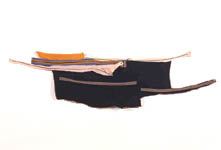Selected Quotes
DeGroodt's sculptures have an integrity and coherence that belie their funky materials and low sources. With a subtlety and attention to detail rivaling Richard Tuttle, DeGroodt adds poignantly homemade touches to his assemblages, imbuing them with an urgent presence that is missing in so much contemporary work.
Michael Duncan, Art In America
| The Supreme Perhaps |
2000
|
At a time when the art that makes the most noise seems to get the most attention, its refreshing to see works whose need for attention is exceeded by their formal authority. Time slows down before DeGroodt's collages. Each of DeGroodt's drawings is actually several drawings in one. Laid out in casual, relaxed compositions, their components look as if they were shuffled like a deck of cards, until the artist found an arrangement that suited his mood. A sense of ad hoc adaptability-or potentially infinite rearrangeability-takes shape in these unpretentious pieces, which are anything but precious.
DeGroodt's sculptures fall into two catagories: rows of cardboard boxes that have been wrapped in old clothes as if they were presents, and loose sections of frabic that either have been push pinned to the wall or suspended, like flags from monofilament. Both emphasize their provisional, temporary nature, which will only last as long as they are cared for. This unsentimental wisdom gives them their fragile beauty.
David Pagel, Los Angeles Times
|
||||
| Ghazal 418 (red boxes) |
1998
|
What I have realised is that DeGroodt makes works, wholes, that are indeed as great as the sum of their parts because he is able to see in a part greatness that I couldn't have seen in an afternoon of staring. DeGroodt is able, and just as importantly willing, to view parts for their potential in possible wholes rather than in specific wholes, and the results involve composite forms that are visually elegant and material combinations that are poetically eloquent.
Chris Miles, The Part to the Whole catalogue
| Trilogy (The Beckett Project) |
1996-1999
|
Trilogy (The Beckett Project) 1996-1999, is a series of three stacked tire skins, each a stand-in for for one of Beckett's novels, Molloy, Malone Dies, and the Unnamable. Within each mound, electric speakers emit a prerecorded low rumbling sound, vibrating a pile of shredded paper excerpts from the texts like a salad of chinese fortunes. Beckett's robbing of each word's intrinsic meaning through mesmeric repetition is perfectly mirrored by DeGroodt's pulsing nonverbal hums. Both seem to anticpate the narrative exhaustion of their respective genres, creating melancholy ballads of perseverance whose reward is a realignment of the process of looking.
David Hunt, Flash Art
 |
|
| Then the True Night |
1998
|
Steve DeGroodt's work underscores Kant's observation that "artists have a talent for producing that which no definite rule can be given." Like Samuel Beckett, DeGroodt is interested in the humble and ignored, what Robert Davis calls the "fifth business," referring to the bit players who can only indirectly impact plot action. The body of work discussed here derives in large part from Beckett's trilogy of novels, Molloy, Malone Dies, and The Unnamable, which link the freedom to invent with the compulsive need to express. DeGroodt's sensibility draws from Beckett's humor and slapstick sense of failure and shares the perception that language is incapable of meaningful expression. Objects offer DeGroodt a way to avoid the chaos of language.
Kay Whitney, Sculpture magazine



